The temperature is rising and the world is getting increasingly dangerous, even the rich bits. Former Tuvalu PM slams Australia’s climate policies. Rights of and around rivers.
All of the last 12 months were the hottest on record
The graph below shows the average global temperature increase above the pre-industrial level (1850-1900) for each month, year by year, since January 1940. It clearly displays that the world is getting hotter. It also shows that it has been happening consistently for 80 years and that the rate of warming is accelerating (the lines for each June-May period are further apart as we move through the decades from bottom to top).
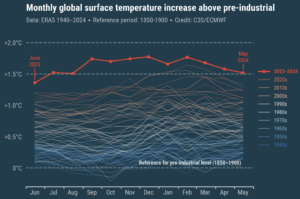
Also noteworthy is that every one of the last eleven months has been at least 1.5oC above the pre-industrial average. The average temperature over the year of June 2023-May 2024 was 1.63oC above the pre-industrial average – the hottest twelve-month period on record.
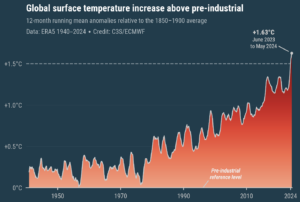
Although it is likely that the monthly global average temperature increase will fall sometime soon, at the moment we are overshooting the aspirational Paris boundary of 1.5oC. This does not mean that the Paris goal has been surpassed as that relates to an average 1.5oC increase over a 30-year period. That is currently hovering around 1.2oC.
Hotter climate, more extreme weather events, more deaths
The frequency of severe weather events in the USA has increased about six-fold since the early 1980s (graph below). Half of the events (383 in total) have been severe storms but they account for only a sixth of the total financial cost (2.7 billion US dollars), whereas tropical cyclones account for a sixth of the events but half of the cost.
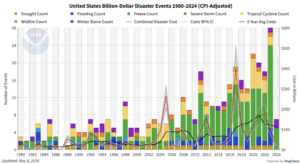
Over the 44-year period, the severe weather events caused over 16,000 deaths. Cyclones were the major culprit (42%), followed by droughts (28%, despite causing only 8% of the events) and severe storms (13%). The number of deaths from these events was around 300 per year until 2010 and has now increased to around 500 per year. It’s interesting that heatwaves, the leading cause of death from extreme weather events in Australia, aren’t included in the USA’s count.
The inevitability of increasingly dangerous weather conditions caused by continuing global warming was made clear in 2021 in the IPCC’s Sixth Assessment Report that focused on the physical science basis of climate change: ‘With every additional increment of global warming, changes in [weather] extremes continue to become larger.’ The report stated that every additional 0.5°C of global warming causes clearly discernible increases in the intensity and frequency of land and marine heatwaves, heavy precipitation, droughts and tropical cyclones, all of which will have severe consequences for human health and habitations and food production.
Bellamy Foster and Clark sum up the inevitable short-term disasters and the still avoidable longer term existential threat as follows:
‘Capitalism has brought the world to the edge of the abyss. Humanity, therefore, is facing issues of ecological survival on two levels: (1) a still reversible but rapidly worsening Earth System crisis, threatening to undermine civilisation as a whole and make the planet uninhabitable for the human species, and (2) accelerating extreme weather and other ecological disasters associated with climate change that are now unavoidable in the coming decades, affecting localities and regions throughout the globe.’
Turn this canoe around and stop the madness
In March, the Right Honourable Enele Sopoaga PC, Former Prime Minister of Tuvalu (highest point above sea level, four metres) delivered the keynote address at The Australia Institute’s Climate Integrity Summit.
In calm, measured tones, Mr Sopoaga delivered a damning condemnation of Australia’s attitude to Pacific peoples on the issues of climate change, security contracts that undermine Tuvalu’s sovereignty, nuclear submarines in the Pacific, and support for nuclear power in Australia.
According to Mr Sopoaga, Tuvalu’s relationship with Australia ‘becomes more and more strained with every day that passes’, and ‘while Australia pretends to be good friends with the Pacific, it continues to export coal and gas’, which he described as ‘irresponsible, foolish, and shortsighted’ – the current government being no better than the last, he said.
Australia has high hopes of hosting the 2026 climate change Conference of the Parties in partnership with Pacific nations. I have very mixed feelings about this. While I can see that this will raise the profile of climate change in Australia, I very much doubt that a Labor or Coalition government will change their climate policies to meet the needs of Pacific nations – our ‘Pacific family’, as our politicians risibly like to refer to them, impertinently confusing neighbours with family. I very much hope that the Pacific leaders drive an extremely hard bargain before agreeing to partner with Australia and that they walk away from anything less, publicly revealing our governments’ duplicity for all to see.
Who owns (and owned) the Murray Darling’s water?
Despite sharing the concerns of many about the longstanding mistreatment and current ill-health of the Murray Darling River and its many tributaries, I must admit to a rather sketchy knowledge of its geography, crops, dams, water flows, etc. As for water rights and how they are traded, and the rules governing the harvesting of water on floodplains, well … pretty much a closed book, I’m afraid.
A detailed article in Bloomberg Green tries to clarify, without total success, many of these issues. There are, however, some informative graphics, including a readily-understandable map of the Basin
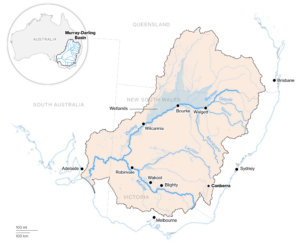
… and data about the decreasing water flows in some of the Murray Darling’s tributaries and the ups and downs of various crops’ production levels.
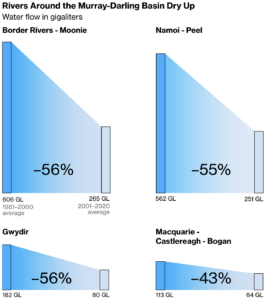
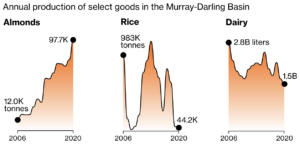
Perhaps most contentiously, and to the obvious consternation of the authors, the article discusses the the harvesting of water in the northern Darling floodplain and the concentration of licenses in a few hands, particularly the extended Harris family of farmers and PSP-AFF. The latter is a joint venture of Australian Food & Fibre and the retirement fund of the Royal Canadian Mounted Police (wot, not the Chinese?!?). PSP-AFF is Australia’s largest cotton producer.
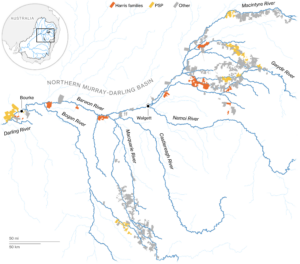
Although the article itself is a bit daunting, I can recommend the 10-minute video within it, ‘How a fight for water is reshaping Australia’. This largely focuses on the loss of the rights of the Aboriginal communities who have lived along the river. It features Dr Erin O’Donnell, a water law and policy expert from the University of Melbourne Law School, who is particularly informative about the legal history.
Can a river sue you in court? Can you sue a river?
In looking for more information about Dr O’Donnell, I came across this short BBC video about the decision in 2017 to grant legal rights to the Whanganui River in New Zealand’s north island. As well as presenting the perspective of the Indigenous Whanganui Iwi, the implications of granting legal personhood to a river are discussed. O’Donnell considers not just the rights of the river, how these are protected and the benefits that might flow to the river and the local communities, but also the ways in which granting legal rights to ‘nature’ can backfire.
Japan starts hunting fin whales again
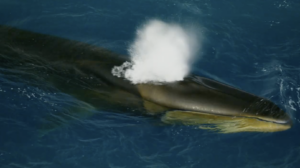
Fin whales are the second largest animal on the planet. Almost 50,000 fin whales were slaughtered in the North Pacific before the global moratorium on commercial whaling began in 1986. Their current numbers are unknown but they are listed as Vulnerable by the International Union for Conservation of Nature.
Japan, which left the International Whaling Commission in 2019 to recommence whaling in its exclusive economic zone, has now added fin whales to its list of commercial whaling species.
Always room for another stupid idea
Because carbon credits and biodiversity credits have been so successful at reducing the atmospheric level of CO2 and halting the loss of biodiversity. And because plastic recycling has been so successful at reducing the islands of plastic waste in the oceans and the mountains of it on developing country beaches. And because multinational corporations have a total commitment to ethical practices and environmental sustainability …
… because of all that, I’m delighted to announce that coming to a waste recycling centre near you soon … Plastic Offsets. Brilliant. Why hasn’t somebody thought of it before? It’s so simple:
Step one: big plastic producers (basically the major oil and gas companies) and big plastic polluters (Coca Cola, Pepsi, Colesworth and the like) pay third world kids to pick plastic off those mountains on their doorsteps (doorstep? door ?? home???) or sponsor community groups to clean up their local beach.
Step two: the companies receive Plastic Offset certificates from some dodgy plastic waste collection and recycling accreditation body. One that’s been endorsed by the World Bank, of course.
Step three: the companies use those offsets to assert ‘plastic neutrality’ or ‘net zero plastic’ and promote their green credentials publicly, all the while continuing to increase their plastic production and use levels.
What could possibly go wrong. Plastics free world just around the corner. Yeah? Nah!
Zombie cicadas
The prime numbers 13 and 17 and their product 221. Thomas Jefferson. Foraging ants. The Great Southern Brood. I’m providing only a few key words for this piece. I hope they encourage you to read two short articles in Nature.

Peter Sainsbury is a retired public health worker with a long interest in social policy, particularly social justice, and now focusing on climate change and environmental sustainability. He is extremely pessimistic about the world avoiding catastrophic global warming.
